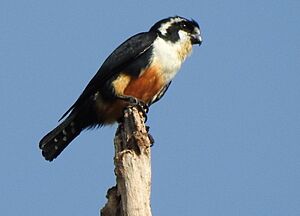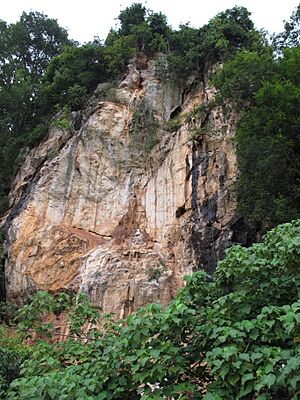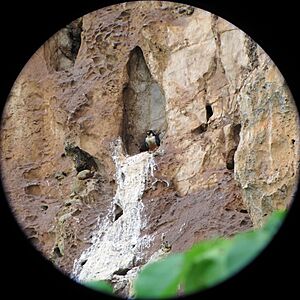Black-thighed falconet facts for kids
Quick facts for kids Black-thighed falconet |
|
|---|---|
 |
|
| Conservation status | |
| Scientific classification | |
| Genus: |
Microhierax
|
| Species: |
fringillarius
|
 |
|

The black-thighed falconet (Microhierax fringillarius) is one of the smallest birds of prey. It is about the size of a typical sparrow. These tiny birds are usually between 14 and 16 centimeters (5.5 to 6.3 inches) long. Their wingspan is about 27 to 32 centimeters (10.6 to 12.6 inches).
You can find this falconet in countries like Brunei Darussalam, Myanmar, Thailand, Malaysia, Singapore, and Indonesia. Sometimes, it might even visit Sri Lanka.
Contents
About the Black-thighed Falconet
How it Got its Name
The Black-thighed Falconet was first studied and described a long time ago. In 1820, a scientist named Thomas Horsfield talked about a type of falconet from Java. Later, in 1824, Auguste Drapiez gave it the scientific name Falco fringillarius. This is how it got its official scientific identity.
What it Looks Like
This falconet is a very small bird that looks a bit like a shrike. It has a tail that often spreads out. The adult male is shiny black on its back. It has a white stripe on its forehead that curves around its black cheeks. Its throat can be white or a reddish-brown color. The chest is white, fading into a reddish-brown belly. Its upper legs and sides are black.
When flying, the male has white wings underneath. There are black stripes on the main flight feathers. The tail is mostly black with three white bars underneath. The adult female looks much like the male, but her tail is a bit longer. Young falconets look like the adults, but the white parts of their head are more reddish-brown.
What it Sounds Like
The Black-thighed Falconet makes a sharp, high-pitched sound. It often sounds like "shiew." It also has a quick, repeated call that sounds like "kli-kli-kli-kli."
Where it Lives
These falconets usually live in forests and at the edges of forests. They also like open areas with trees. You might often see them near farms, villages, or places where forests are being cleared. They are often found near rivers, streams, and rice fields. They mostly live in areas below 1,500 meters (about 4,900 feet) in height.
What it Eats
The Black-thighed Falconet mainly eats insects. This includes moths, butterflies, dragonflies, and cicadas. Sometimes, they also eat small birds or lizards. They often hunt together in groups, sometimes with up to ten birds. They usually catch their prey during quick flights from a perch.
Family Life and Breeding
These falconets are social birds. They are often seen in pairs or in groups of ten or more. The time they breed depends on where they live. Birds north of the equator usually lay eggs from February to June. South of the equator, like in Java, they lay eggs around November and December.
They often use old nest holes made by barbets or woodpeckers. They don't add any extra material to the nest hole, just insect remains. A female usually lays between 2 to 5 eggs. We don't know exactly how long the eggs take to hatch or when the young birds leave the nest. The adult birds might even use the nest hole as a roosting spot all year round.
How Many There Are
We don't have exact numbers for how many Black-thighed Falconets there are. However, like many tiny falconets, their total numbers are probably higher than we know. Their home range covers a huge area, more than 1.5 million square kilometers (about 580,000 square miles).
Some places, like Sumatra and Borneo, say they are common. In Thailand, they are fairly common. But in Java and Bali, they are seen less often. It seems there are tens of thousands of these birds. They also seem to be able to live even when their habitat is changed a bit by humans.
See also
- Smallest organisms



